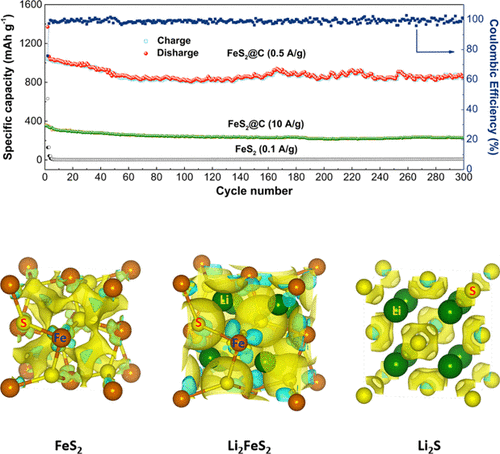当前位置:
X-MOL 学术
›
ACS Appl. Energy Mater.
›
论文详情
Our official English website, www.x-mol.net, welcomes your
feedback! (Note: you will need to create a separate account there.)
Dual-Constrained Sulfur in FeS2@C Nanostructured Lithium-Sulfide Batteries
ACS Applied Energy Materials ( IF 5.4 ) Pub Date : 2020-10-29 , DOI: 10.1021/acsaem.0c01929 Xiaozhe Jin 1 , Song Gao 2 , Aimin Wu 1 , Jijun Zhao 3 , Hao Huang 1 , Guozhong Cao 4
ACS Applied Energy Materials ( IF 5.4 ) Pub Date : 2020-10-29 , DOI: 10.1021/acsaem.0c01929 Xiaozhe Jin 1 , Song Gao 2 , Aimin Wu 1 , Jijun Zhao 3 , Hao Huang 1 , Guozhong Cao 4
Affiliation

|
Irreversible consumption of sulfur aroused from shuttle reaction is the major challenge for liquid electrolyte lithium–sulfur batteries, although various sulfur-based cathodes have been designed. In this work, strict constraint of sulfur to eradicate the polysulfide shuttling is realized in the nanostructure of carbon-coated metal sulfides instead of pure sulfur cathodes. The nanoparticles are composed of a carbon shell and iron disulfide core (FeS2@C), fabricated by the plasma evaporation method and postsulfurization. The Fe–S bonds in FeS2 chemically attract the sulfur atoms during their lithiation reaction, while the carbon shell physically blocks the sulfur loss within the enclosed construction. Owing to the remarkable dual constraint of S, the FeS2@C cathode delivers a stable specific capacity of 862 mA h g–1 after 300 cycles. The assembled battery cells exhibit stable electrochemical performance when they are operated safely in the temperature range from 60 to −25 °C.
中文翻译:

FeS 2 @C纳米结构硫化锂电池中的双重约束硫
尽管已经设计了各种基于硫的阴极,但由于穿梭反应而引起的不可逆的硫消耗是液体电解质锂-硫电池的主要挑战。在这项工作中,在覆盖碳的金属硫化物的纳米结构中,而不是在纯硫阴极上,实现了严格的硫消除多硫化物穿梭的约束。纳米粒子由碳壳和二硫化铁核(FeS 2 @C)组成,通过等离子体蒸发法和后硫化工艺制备。FeS 2中的Fe–S键在锂化反应过程中化学吸引硫原子,而碳壳物理上阻止了封闭结构中的硫损失。由于S的显着双重约束,FeS 2@C阴极在300个循环后可提供862 mA hg –1的稳定比容量。当组装的电池在60至-25°C的温度范围内安全运行时,它们表现出稳定的电化学性能。
更新日期:2020-11-23
中文翻译:

FeS 2 @C纳米结构硫化锂电池中的双重约束硫
尽管已经设计了各种基于硫的阴极,但由于穿梭反应而引起的不可逆的硫消耗是液体电解质锂-硫电池的主要挑战。在这项工作中,在覆盖碳的金属硫化物的纳米结构中,而不是在纯硫阴极上,实现了严格的硫消除多硫化物穿梭的约束。纳米粒子由碳壳和二硫化铁核(FeS 2 @C)组成,通过等离子体蒸发法和后硫化工艺制备。FeS 2中的Fe–S键在锂化反应过程中化学吸引硫原子,而碳壳物理上阻止了封闭结构中的硫损失。由于S的显着双重约束,FeS 2@C阴极在300个循环后可提供862 mA hg –1的稳定比容量。当组装的电池在60至-25°C的温度范围内安全运行时,它们表现出稳定的电化学性能。

































 京公网安备 11010802027423号
京公网安备 11010802027423号